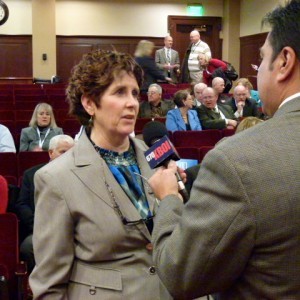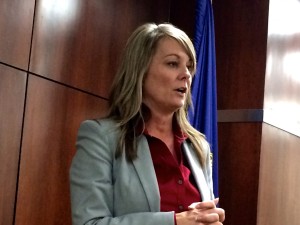The 2014-15 teacher evaluation numbers are in — and the results are virtually unchanged from 2013-14.
Ninety-eight percent of the state’s teachers received scores of “distinguished” or “proficient,” the top two ratings available. Only 2 percent of teachers scored “basic,” the same percentage as 2013-14. And only .2 percent of teachers received an “unsatisfactory” rating — translating to one out of every 500 educators statewide.
These three percentages are identical to the 2013-14 ratings, first reported by Idaho Education News in June.
Leaders of three key education groups defended the evaluations. But a spokesman for Gov. Butch Otter said the numbers show that local school administrators need “ongoing training” in the task of evaluating their staff.
Either way, the evaluation process will eventually play an increased role in teacher pay. In 2015, Otter and the Legislature agreed on a career ladder — a five-year, $125 million plan to boost teacher pay, with raises tied in part to evaluations.
What the numbers say
District and charter school administrators submitted 2014-15 evaluations to the State Department of Education between February and May. Idaho Education News obtained evaluation statistics under the Idaho public records act. (Click here to download the numbers by district and charter school.)
The new results reveal several flaws — and wide variations in the way local administrators apply the four-tiered rating system.
Across-the-board scores. Twenty of Idaho’s 115 districts and 16 of Idaho’s 47 charters did not differentiate between teachers, assigning identical scores across the board. In 19 districts and 14 charters, that translated to uniform scores of proficient.

This list includes the New Plymouth School District. Retiring superintendent and state Rep. Ryan Kerby told Idaho Education News that his district has deliberately awarded identical ratings, arguing that individual teacher ratings are not the state’s business. As a House Education Committee member, Kerby was a prominent figure in this year’s debate over the career ladder.
Distinguished scores. North Idaho’s Mullan School District gave its entire faculty a distinguished rating, the highest rating available. So did theIdaho Digital Learning Academy, a virtual school, and the Upper Carmen Public Charter School in Lemhi County.
The West Ada School District gave nearly 500 teachers distinguished marks. That accounts for more than one-fifth of the distinguished marks statewide — even though West Ada hires slightly more than a tenth of the state’s teaching staff.

On the other hand, the Boise School District awarded none of its 1,879 teachers a distinguished grade. The district does not give out any distinguished ratings, as a matter of policy. “Other avenues are available for teachers to demonstrate ‘distinguished’ performance,” Superintendent Don Coberly wrote in a recent blog post about the evaluations process.
Unsatisfactory scores. This lowest rating was used sparingly — and applied inconsistently. Only 16 districts and three charters used the rating at all. And the Boise district accounted for 12 of the 37 state’s unsatisfactory ratings, even though the district accounts for less than 10 percent of the state’s teaching staff.
A flawed system?
It’s up to local administrators to decide how to evaluate teachers. For example, that’s how the neighboring West Ada and Boise districts can wind up interpreting distinguished work so differently.
But evaluations now take on broader significance, with the passage of the career ladder. The career ladder is designed to replace Idaho’s old salary structure — one in which raises were based on a teacher’s experience and academic resume. Career ladder raises will be based in part on evaluations and student growth, although, again, it’s also up to districts to decide whether to adopt the new salary schedule.

While the evaluations are heavily skewed toward the top end of the scoring table, Idaho School Boards Association executive director Karen Echeverria bristles at the suggestion that the system is flawed. “I don’t know that we know that yet.”
Rob Winslow also wants to keep the system in place. He’s the executive director of the Idaho Association of School Administrators — so the task of evaluations falls to his membership.
Winslow sees merit in the current system. Even if the evaluations affect raises for only 2 percent of teachers, those scoring below proficient, it’s still a refinement over the old, experienced-based system that allowed all teachers to move up the salary schedule. He also has no problem seeing 98 percent of teachers getting at least a proficient grade. “Otherwise, why’d you hire them or keep them?”

Idaho Education Association President Penni Cyr echoed those sentiments. “The latest teacher evaluation results validate what the IEA and its members already know — there are many, many outstanding teachers in Idaho who are doing an amazing job under less-than-ideal circumstances.”
Presented with Idaho Education News’ findings — and the same numbers presented to Echeverria, Winslow and Cyr — Otter spokesman Jon Hanian had a different takeaway.
“The data regarding trends in teacher evaluations highlights the need for ongoing training for administrators in how to conduct the evaluations as they should be done,” Hanian said Tuesday. “It is essential that administrators get the necessary support and training for consistent implementation.”
And that, too, is part of the career ladder. When school administrators seek recertification, they will need to complete a three-credit course in performing teacher evaluations.
A yardstick — or a punitive measure?
The job of reviewing the evaluation process will fall largely to state superintendent Sherri Ybarra and the State Department of Education.

Ybarra is putting together a committee that will audit the local evaluations. The goal of the spot-check is “to determine how evaluators are fully utilizing the state evaluation standards,” Ybarra spokesman Jeff Church said. The ISBA, IASA and the IEA — stakeholder groups that played a pivotal role in crafting the career ladder — have been invited to nominate representatives for the review committee.
Ybarra and the committee will have some time to do their work. The current evaluations have no bearing on the career ladder. But next year’s evaluations will be a factor in determining whether teachers move from the beginning, “residency” rung of the career ladder, to professional status.
Ybarra enters the process with reservations. She is skeptical about the state’s approach, which bases evaluations on the Charlotte Danielson Framework for Learning, a teacher improvement tool.
She isn’t the only skeptic.
Evaluations are useful, Cyr said, but should not be “punitive” or used to determine pay.
The evaluation language was a concession, and a piece of building the career ladder law, but Coberly harbors deeper concerns. “Unfortunately, beginning with the failed Students Come First legislation, many in the state have become as obsessed with teacher evaluations as they have standardized testing.”
Idaho Education News data analyst Randy Schrader compiled evaluations statistics for this report.
